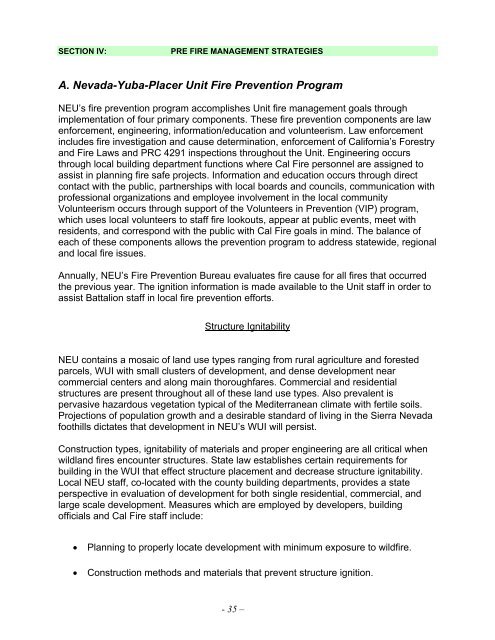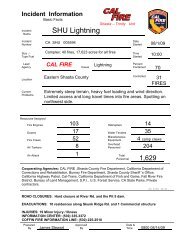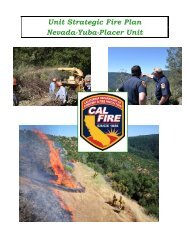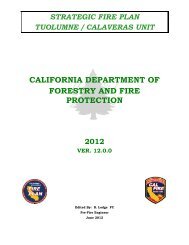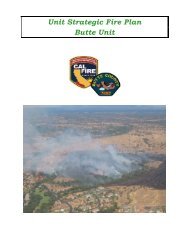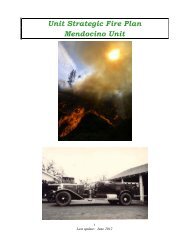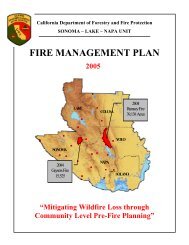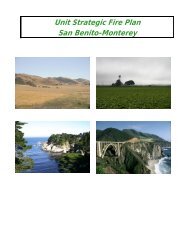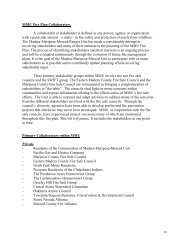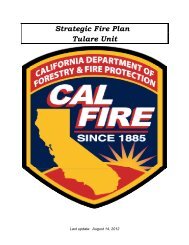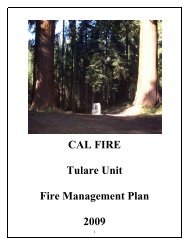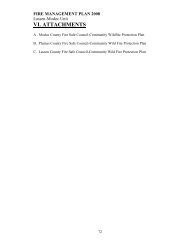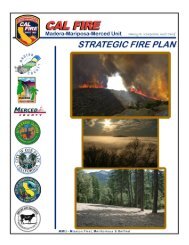Nevada-Yuba-Placer Strategic Fire Plan 2011 - Board of Forestry ...
Nevada-Yuba-Placer Strategic Fire Plan 2011 - Board of Forestry ...
Nevada-Yuba-Placer Strategic Fire Plan 2011 - Board of Forestry ...
Create successful ePaper yourself
Turn your PDF publications into a flip-book with our unique Google optimized e-Paper software.
SECTION IV: PRE FIRE MANAGEMENT STRATEGIES<br />
A. <strong>Nevada</strong>-<strong>Yuba</strong>-<strong>Placer</strong> Unit <strong>Fire</strong> Prevention Program<br />
NEU’s fire prevention program accomplishes Unit fire management goals through<br />
implementation <strong>of</strong> four primary components. These fire prevention components are law<br />
enforcement, engineering, information/education and volunteerism. Law enforcement<br />
includes fire investigation and cause determination, enforcement <strong>of</strong> California’s <strong>Forestry</strong><br />
and <strong>Fire</strong> Laws and PRC 4291 inspections throughout the Unit. Engineering occurs<br />
through local building department functions where Cal <strong>Fire</strong> personnel are assigned to<br />
assist in planning fire safe projects. Information and education occurs through direct<br />
contact with the public, partnerships with local boards and councils, communication with<br />
pr<strong>of</strong>essional organizations and employee involvement in the local community<br />
Volunteerism occurs through support <strong>of</strong> the Volunteers in Prevention (VIP) program,<br />
which uses local volunteers to staff fire lookouts, appear at public events, meet with<br />
residents, and correspond with the public with Cal <strong>Fire</strong> goals in mind. The balance <strong>of</strong><br />
each <strong>of</strong> these components allows the prevention program to address statewide, regional<br />
and local fire issues.<br />
Annually, NEU’s <strong>Fire</strong> Prevention Bureau evaluates fire cause for all fires that occurred<br />
the previous year. The ignition information is made available to the Unit staff in order to<br />
assist Battalion staff in local fire prevention efforts.<br />
Structure Ignitability<br />
NEU contains a mosaic <strong>of</strong> land use types ranging from rural agriculture and forested<br />
parcels, WUI with small clusters <strong>of</strong> development, and dense development near<br />
commercial centers and along main thoroughfares. Commercial and residential<br />
structures are present throughout all <strong>of</strong> these land use types. Also prevalent is<br />
pervasive hazardous vegetation typical <strong>of</strong> the Mediterranean climate with fertile soils.<br />
Projections <strong>of</strong> population growth and a desirable standard <strong>of</strong> living in the Sierra <strong>Nevada</strong><br />
foothills dictates that development in NEU’s WUI will persist.<br />
Construction types, ignitability <strong>of</strong> materials and proper engineering are all critical when<br />
wildland fires encounter structures. State law establishes certain requirements for<br />
building in the WUI that effect structure placement and decrease structure ignitability.<br />
Local NEU staff, co-located with the county building departments, provides a state<br />
perspective in evaluation <strong>of</strong> development for both single residential, commercial, and<br />
large scale development. Measures which are employed by developers, building<br />
<strong>of</strong>ficials and Cal <strong>Fire</strong> staff include:<br />
• <strong>Plan</strong>ning to properly locate development with minimum exposure to wildfire.<br />
• Construction methods and materials that prevent structure ignition.<br />
- 35 –


